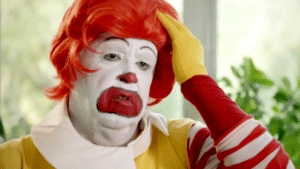
McD’s ‘$5 Meal Deal’ an un-happy economic indicator
Mickey Kim and Roger Lee / August 30, 2024

Everywhere you turn, from television to billboards to social media, your senses are bombarded by a cacophony of “value deals” from fast-food and casual dining chains. Restaurant traffic and profits are down, so have responded by aggressively promoting “deals.” These tend to be “loss-leaders” meant to entice customers to visit in hopes they will also purchase higher margin items (see our column on Red Lobster’s ill-fated “Ultimate Endless Shrimp” promotion).
For example, let’s look behind McDonald’s introduction of the “highly anticipated” $5 Meal Deal, available starting June 25 for a “limited time” (subsequently extended through August and possibly beyond). The $5 Meal Deal is a calculated response to growing concerns over affordability in the dining sector, a canary in the coal mine that prices have gone too far.
This initiative is more than just providing affordable meals; it reaffirms McDonald’s commitment to value, a foundational element of its brand identity. “Consumers still recognize us as the value leader against our key competitors, but it’s clear that our value leadership gap has recently narrowed. We are working to address this with urgency,” stated Chris Kempczinski, McDonald’s CEO.
The deal included a choice of a McDouble® or McChicken® sandwich, plus a 4-piece Chicken McNuggets®, small fries and a small drink. Franchisees own and operate (including setting their own menu prices) more than 95% of McDonald’s U.S. restaurants and had to be convinced by corporate that a short-term hit to their already beleaguered profit margins was a good long-term investment. Coca-Cola chipped-in marketing funds to soften the blow and eventually seal the deal (no pun intended).
The introduction of the $5 Meal Deal presaged a decidedly not-so-delicious earnings report for the second quarter (April-to-June 2024), as McDonald’s announced a surprise drop in sales worldwide, its first decline in 13 quarters (since COVID lockdowns ended). “Same-store sales” (sales at restaurants open a full year, both franchise- and company-owned) decreased 1% worldwide, with negative guest counts.
Other combatants in the “value menu war,” include:
- Burger King’s $5 “Your Way” meal, offering your choice of a WhopperR, Chicken Jr. or Bacon Cheeseburger, plus 4 pc. chicken nuggets, value fries and a value drink.
- Taco Bell’s $7 “Luxe Cravings Box,” filled with a Chalupa SupremeR, Beefy 5-Layer Burrito, Double Stacked Taco, chips with cheese sauce and a medium drink.
- Even Starbucks has jumped into the value menu fray with its “Pairings Menu” bundling a tall hot or iced coffee or tea with a croissant ($5) or breakfast sandwich ($6 or $7).
Starbucks is an interesting case. Founder Howard Schultz was in his third stint as CEO when Laxman Narasimhan signed-on as “CEO-elect” in September 2022, hailing him as “a strategic and transformational leader with deep experience in building powerful consumer brands, driving innovations that create loyalty and convenience for consumers.”
Shultz turned over the CEO reigns in March 2023. Fast forwarding to this July 30, Starbucks reported its second consecutive quarterly decline in same-store sales, with a whopping 6% decline in U.S. guest traffic, which Narasimhan attributed to “a more cautious consumer spending environment and intensified competition.” He urged patience as he saw “green shoots” in the company’s three-part action plan to improve its U.S. business.
With the stock down 20% in 2024 and “activist” investors Elliott Investment Management and Starboard Value prowling, Starbucks announced on August 13 Narasimhan was no longer CEO and would be replaced by Chipotle CEO Brian Niccol. According to Bloomberg, board Chair Mellody Hobson said the company initiated discussions about leadership of the company “several months ago” and Schultz had hailed the hiring of Niccol as CEO to replace Narasimhan as a “home run.”
The stock jumped 24% on the news and the “Pairings Menu” vanished as quickly as the CEO.
The malaise facing fast-food restaurants can be attributed to low- and middle-income consumers being under increasing financial stress. Pandemic-era stimulus checks and related savings are long gone. Higher interest rates have helped savers, but punished borrowers. Similarly, the “haves” have benefitted from an ebullient stock market, “have nots” haven’t.
Recent headlines cheer the annual change in the Consumer Price Index (CPI) has finally fallen below 3%. While this is welcome news, the cumulative damage from three years of high inflation (peaked at 9.1% in June 2022) has taken a toll.
Measuring inflation has always been problematic and controversial. CPI is calculated using arbitrary weights of a basket of goods and utilizes “hedonic” adjustments for the quality of goods in the basket. Strategas Research Partners developed a “Common Man CPI,” which focuses on items people must buy regularly—food, energy, shelter, clothing, utilities and insurance. While CPI has increased 22.4% since the end of 2019, Common Man CPI has increased 24%. Grocery prices have increased a similar 24.3%, but fast-food prices have soared 31.8%.
In today’s ultra-competitive restaurant industry, it’s evident that consumers are looking for more than just calories; they want options that align with their constrained budgets. The old economic adage the solution to high prices is high prices is true and the “race to the bottom” will continue to be painful.
The opinions expressed in these articles are those of the author as of the date the article was published. These opinions have not been updated or supplemented and may not reflect the author’s views today. The information provided in these articles are not intended to be a forecast of future events, a guarantee of future results and do not provide information reasonably sufficient upon which to base an investment decision and should not be considered a recommendation to purchase or sell any particular stock or other investment.









